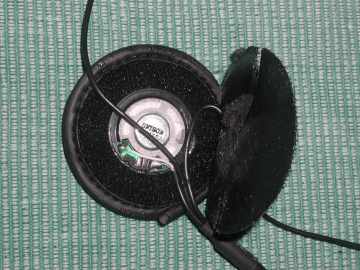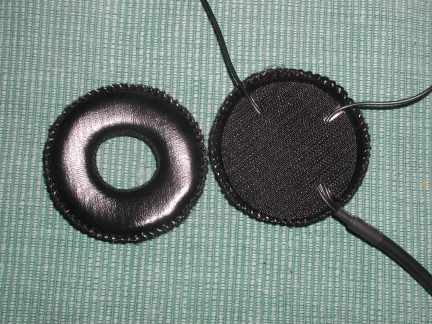These are attached to the k series headset ear speaker , they are usually supplied with each k series headset , If applied correctly , will improve the clarity of sound/speech heard inside the noisy motorcycle headset environment , the correct attachment is a one time process as once stuck they cannot be removed with out destroying them . make sure your helmet is not too tight when trying them as too much pressure on the ear albeit from soft foam rubber ,could become painful after some time . The major problem with communications on a motorcycle, be they wired or wireless is hearing ! There is some noise advantage in having your head inside a somewhat closed container fitting snugly around your head whilst you travel along at 100 Kph!! . Helmet wind noise is such a variable.
From half helmets , open face, through to full face helmets and all have different volumes of generated noise depending whether you ride a cruiser , sport bike, chopper, have a windscreen ,fairing and the speed you travel at on the open road . Quite a few helmet manufacturers have ranges of wind noise volumes specified in dBA at various riding speed . There is a great variation in wind noise in helmets and it is the high frequency of wind noise that tends to drown out the information carrying high frequency of articulation that interferes with understanding of speech . A lot of helmets produce ( greater than ) >90dBA of noise at motorway speeds , this level of noise in your ears for a long period of time can be quite fatiguing and cause some potential damage on a long ride, that is why earplugs are such a good idea when riding long distance , they reduce the broadband high level noise fatigue .
You do not want to run your intercom/radio/MP3 at extra loud volume to hear over the background noise this will be bad for your long term hearing viability as the total sound level entering your ear ( radio plus wind noise) can easily be up bordering on the permanent hearing damage level . You must keep the sound level into your ears at a comfortable level. When the headset system was designed , I wanted a system that is simple to use , does not modify helmet, motorcycle (or rider) , something that is easy to install and remove, something that just about anyone with minimal experience can install and remove and Swap between helmet and Bike at will .



Peel open headset Insert speaker in hole stick velcro to earcushion
After developing the successful headset . I thought of ways to easily and simply reduce the background noise even further , so I thought along the principle of the Ear defenders or ear muffs with their peripheral acoustic seal and thought that something along that line will help improve received speech recognition and cut down on the fatigue producing wind noise. I saw the soft cushions around some computer headsets , obtained some found they improved reception and cut down on background noise, I tested many types of cushion , settled on one variation, so I purchased a few thousand suitable ear cushions ! The ear cushions supplied with the headsets provided by PHS Ltd are an attempt to reduce the amount of extraneous noise entering the ear whilst riding and thus make it easier to hear music and understand speech .The ear cushions provide a peripheral acoustic seal around the outer surface of the ear , the sound deadening material the covered cushion is made from , serves to reduce the amount of high frequency noise reaching the ear from outside , the hole in the centre where the ear speaker is placed ,is in the optimum position to provide more than enough volume to the wearer, We are attempting to increase the signal to noise ratio and thus improve intelligibility . This is where the in ear canal earphones have a distinct advantage over most other systems in that a close fitting earplug will block a huge amount of extraneous noise and render the received sound clearer . Ear plugs speakers are great, but we have kept away from them mainly for two reasons one is a hygiene , and the other is a small amount of additional complexity when putting the helmet on. The PHS supplied ear speakers are easy to peel apart , if you are using the ear cushions (having ascertained that they will not be uncomfortably tight inside your helmet ) you will be left with a small ear speaker on a wire . Ear cushions have a flat smooth side (with a peripheral cloth that can be folded back over the shiny side and Velcro hook disk,) that faces the helmet lining and a bulbous leatherette side that faces the ear . The ear speaker fits inside the ear cushion, with its sound holes facing the wearers ear , the sticky sided Velcro hooked disk sticks to smooth surface of the ear cushion ,covering the back of the ear speaker thus holding the ear speaker inside the ear cushion and such is able to stick to the "wool" lining inside the helmet . It is important to make sure the ear cushions are placed correctly over the ear for maximum effect.
For added comfort you can run a bead of adhesive around the periphery of the ear speaker where it makes contact with the ear cushion this will stop the ear speaker eventually migrating through the hole in the centre and impinging on parts of your ear . Some helmets are a very tight fit and thus you may not be able to make great use of the ear cushions ( unless your helmet has deep recesses to accommodate the ear speakers ) If the ear cushions are a tight fit in your helmet you will find that after a little while you will get sore ears because of the constant pressure. The standard ear speakers with the original felt covers will be usable in just about any helmet as they are very thin , if you decide to not use the ear cushions then I suggest you glue the original felt ear cushions to the sticky back velcro disk to stop them peeling apart.